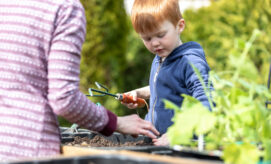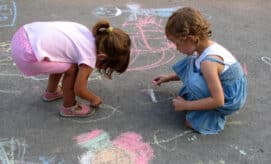During early childhood, exploring and spending time in nature and the outdoors is not only fun – it is an important part of supporting young children’s learning and development. When we cultivate outdoor environments that encourage children to connect with nature, we create rich experiences that foster their curiosity and care for the world around them. In this article, we share a few simple and creative ways that early learning providers can invite more birds, insects, plants, and natural materials into their outdoor spaces.
1. Set up Bird Baths
Setting up a small birdbath in your yard is a simple but effective way to encourage more birds to visit your outdoor space. Bird baths provide birds with drinking water and a place to bathe and cool off, benefits that are especially inviting during the warm months of late spring and summer.
When birds visit your birdbath, children get to learn by observing them drinking the water and cleaning their feathers. You might even offer binoculars to the little ones in your care, so they can observe the birds up close without disturbing or frightening them away.
2. Decorate Bird Houses & Boxes
Creating safe nesting places is another great way to invite birds to visit your yard. Children can participate by helping paint and decorate birdhouses for birds to visit. You can find affordable birdhouses at craft stores that young children can paint and decorate with stickers, stencils, and more!
Once the birdhouses are completed, encourage the children to decide upon birdhouse locations that will attract birds while providing the children an opportunity to observe the birds coming and going from their homes. You might enjoy pairing your birdhouse decorating activity with the children’s book Opal’s Springtime Birdhouse, the story of a young girl who tries to make the perfect birdhouse.
3. Make-Your-Own Birdfeeders
Birdfeeders are a fun craft opportunity for young children that also provides a special snack for birds to enjoy when they visit your yard. Using recycled materials and seeds, little ones can make simple birdfeeders that you can hang in your yard so you and the children can enjoy observing the birds as they enjoy a snack!
To help you get started, this website shares a variety of different preschool-friendly ways to make birdfeeders with the little ones in your care.
4. Utilize Natural Play Materials
A simple way to invite more nature into your yard is to encourage children to explore all of the different natural materials that your yard offers. Encouraging little ones to play with pinecones, rocks, twigs, and even mud encourages them to explore all the elements of nature that exist on the ground, and at the children’s eye-level. You might suggest that the children notice and create small spaces for bugs, insects, and other critters to enjoy!
You might also consider adding more natural items and materials for little ones to explore in your yard by: planting a small garden and asking the children to participate in the garden’s care; pointing out the natural items like rocks and small tree trunks that offer opportunities for jumping, climbing, and sitting; creating areas for water and sand play; and setting out items made of wood and metal, rather than plastic.
5. Grow Pollinator-friendly Plants
Children are often fascinated by the colorful wings of butterflies and the buzzing sound of bumblebees. A simple way to invite more of these pollinator insects into your yard is to incorporate more pollinator-friendly plants such as milkweed, lavender, and sunflowers. These plants provide nectar and pollen to help insects thrive, adding exciting discovery opportunities for little learners while supporting the planet we call home.
If you are interested in learning more about regional native plants that support pollinators, you might enjoy this free resource list, which organizes pollinator-friendly plants by state and region in the US. You can also visit local nurseries and ask what kinds of plants they recommend for your yard.





